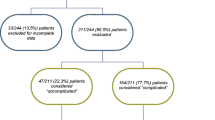Abstract
Despite technical and procedural advances in urodynamics over the past decade, the role of urodynamics in women with stress urinary incontinence (SUI) remains controversial. Many of these advancements have been the result of multicentric studies in the United States, such as the UITN and PFDN, which will be highlighted in this article. It appears to be the consensus that urodynamics may not be needed in pure stress incontinence. Urodynamics can be valuable in unmasking stress urinary incontinence in prolapse, although its impact on the ultimate management of occult incontinence remains debated. This article reviews the indications for urodynamic testing in women with SUI but will exclude more complex conditions such as mixed or recurrent incontinence which are outside the scope of this review.
Similar content being viewed by others
References
Papers of particular interest, published recently, have been highlighted as: • Of importance•• Of major importance
Ward RM, Hampton BS, Blume JD, Sung VW, Rardin CR, Myers DL. The impact of multichannel urodynamics upon treatment recommendations for female urinary incontinence. Int Urogynecol J Pelvic Floor Dysfunct. 2008;19(9):1235–41.
Klutke C, Siegel S, Carlin B, Paszkiewicz E, Kirkemo A, Klutke J. Urinary retention after tension-free vaginal tape procedure: incidence and treatment. Urology. 2001;58(5):697–701.
Nager CW, FitzGerald M, Kraus SR, Chai TC, Zyczynski H, Sirls L, et al. Urodynamic measures do not predict stress continence outcomes after surgery for stress urinary incontinence in selected women. J Urol. 2008;179(4):1470–4.
Nager CW, Brubaker L, Daneshgari F, Litman HJ, Dandreo KJ, Sirls L, et al. Design of the Value of Urodynamic Evaluation (ValUE) trial: a non-inferiority randomized trial of preoperative urodynamic investigations. Contemp Clin Trials. 2009;30(6):531–9.
Schafer W, Abrams P, Liao L, Mattiasson A, Pesce F, Spangberg A, et al. Good urodynamic practices: uroflowmetry, filling cystometry, and pressure-flow studies. Neurourol Urodyn. 2002;21(3):261–74.
Groutz A, Blaivas JG, Sassone AM. Detrusor pressure uroflowmetry studies in women: effect of A 7FR transurethral catheter. J Urol. 2000;164(1):109–14.
Nager CW, Albo ME, Fitzgerald MP, McDermott S, Wruck L, Kraus S, et al. Reference urodynamic values for stress incontinent women. Neurourol Urodyn. 2007;26(3):333–40.
Albo ME, Richter HE, Brubaker L, Norton P, Kraus SR, Zimmern PE, et al. Burch colposuspension versus fascial sling to reduce urinary stress incontinence. N Engl J Med. 2007;356(21):2143–55.
• Richter HE, Albo ME, Zyczynski HM, Kenton K, Norton PA, Sirls LT, et al. Retropubic versus transobturator midurethral slings for stress incontinence. N Engl J Med. 2010;362(22):2066–76. This paper reports the results of the primary outcomes multicenter study TOMUS trial.
Nager CW, Kraus SR, Kenton K, Sirls L, Chai TC, Wai C, et al. Urodynamics, the supine empty bladder stress test, and incontinence severity. Neurourol Urodyn. 2010;29(7):1306–11.
Kuhn A, Nager CW, Hawkins E, Schulz J, Stanton SL. A comparative study of water perfusion catheters and microtip transducer catheters for urethral pressure measurements. Int Urogynecol J Pelvic Floor Dysfunct. 2007;18(8):931–5.
Martan A, Masata J, Petri E, Svabik K, Drahoradova P, Voigt R, et al. Weak VLPP and MUCP correlation and their relationship with objective and subjective measures of severity of urinary incontinence. Int Urogynecol J Pelvic Floor Dysfunct. 2007;18(3):267–71.
•• Nager CW, Brubaker L, Litman HJ, Zyczynski HM, Varner RE, Amundsen C, et al. A randomized trial of urodynamic testing before stress-incontinence surgery. N Engl J Med. 2012;366(21):1987–97. This paper reports the primary outcomes of the VALUE study, investigating the role of UDS prior to anti-incontinence surgery.
van Leijsen SA, Kluivers KB, Mol BW, Broekhuis SR, Milani FL, van der Vaart CH, et al. Protocol for the value of urodynamics prior to stress incontinence surgery (VUSIS) study: a multicenter randomized controlled trial to assess the cost effectiveness of urodynamics in women with symptoms of stress urinary incontinence in whom surgical treatment is considered. BMC Womens Health. 2009;9:22.
Miller EA, Amundsen CL, Toh KL, Flynn BJ, Webster GD. Preoperative urodynamic evaluation may predict voiding dysfunction in women undergoing pubovaginal sling. J Urol. 2003;169(6):2234–7.
Alperin M, Abrahams-Gessel S, Wakamatsu MM. Development of de novo urge incontinence in women post sling: the role of preoperative urodynamics in assessing the risk. Neurourol Urodyn. 2008;27(5):407–11.
Wang AC, Chen MC. The correlation between preoperative voiding mechanism and surgical outcome of the tension-free vaginal tape procedure, with reference to quality of life. BJU Int. 2003;91(6):502–6.
Lemack GE, Krauss S, Litman H, FitzGerald MP, Chai T, Nager C, et al. Normal preoperative urodynamic testing does not predict voiding dysfunction after Burch colposuspension versus pubovaginal sling. J Urol. 2008;180(5):2076–80.
Borstad E, Rud T. The risk of developing urinary stress-incontinence after vaginal repair in continent women. A clinical and urodynamic follow-up study. Acta Obstet Gynecol Scand. 1989;68(6):545–9.
Roovers JP, van Laar JO, Loffeld C, Bremer GL, Mol BW, Bongers MY. Does urodynamic investigation improve outcome in patients undergoing prolapse surgery? Neurourol Urodyn. 2007;26(2):170–5.
Jha S, Toozs-Hobson P, Parsons M, Gull F. Does preoperative urodynamics change the management of prolapse? J Obstet Gynaecol. 2008;28(3):320–2.
Visco AG, Brubaker L, Nygaard I, Richter HE, Cundiff G, Fine P, et al. The role of preoperative urodynamic testing in stress-continent women undergoing sacrocolpopexy: the Colpopexy and Urinary Reduction Efforts (CARE) randomized surgical trial. Int Urogynecol J Pelvic Floor Dysfunct. 2008;19(5):607–14.
Mueller ER, Kenton K, Mahajan S, FitzGerald MP, Brubaker L. Urodynamic prolapse reduction alters urethral pressure but not filling or pressure flow parameters. J Urol. 2007;177(2):600–3.
Ballert KN, Biggs GY, Isenalumhe Jr A, Rosenblum N, Nitti VW. Managing the urethra at transvaginal pelvic organ prolapse repair: a urodynamic approach. J Urol. 2009;181(2):679–84.
Elser DM, Moen MD, Stanford EJ, Keil K, Matthews CA, Kohli N, et al. Abdominal sacrocolpopexy and urinary incontinence: surgical planning based on urodynamics. Am J Obstet Gynecol. 2010;202(4):375 e1–5.
Disclosure
No potential conflicts of interest relevant to this article were reported.
Author information
Authors and Affiliations
Corresponding author
Rights and permissions
About this article
Cite this article
Dillon, B.E., Zimmern, P.E. When Are Urodynamics Indicated in Patients with Stress Urinary Incontinence?. Curr Urol Rep 13, 379–384 (2012). https://doi.org/10.1007/s11934-012-0270-0
Published:
Issue Date:
DOI: https://doi.org/10.1007/s11934-012-0270-0




